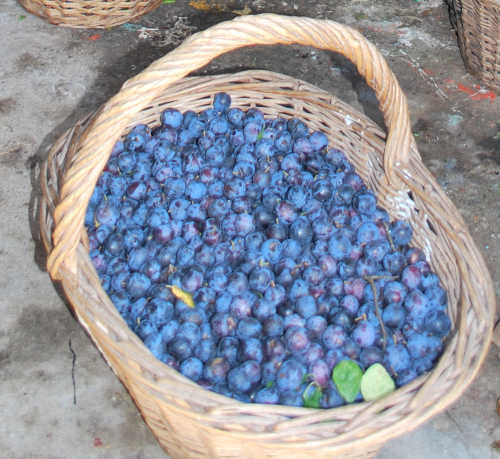Plums & Damsons - In Season
 Everywhere we’ve travelled in recent weeks the cooks of Ireland have been hard at working preserving this year’s heavy crops of fruit and, especially, plums and damsons, or prunus domestica.
Everywhere we’ve travelled in recent weeks the cooks of Ireland have been hard at working preserving this year’s heavy crops of fruit and, especially, plums and damsons, or prunus domestica.
Plums, bullace, damson - as Biddy White Lennon points out in Wild Food (O’Brien Press), there are plenty of variations to argue about but they all seem to be related to the wild cherry and all are plump, juicy stone fruit ranging in colour from yellow right through to the deep purplish blue-black of the wild damson.
The damson trees thrive in hedgerows and odd corners of land, and the fruit - which can be shaken onto a cloth spread under the tree when ripe, in August-September - makes delicious jams, jellies, fruit cheeses and relishes for cheese and cold meats.
When making plum jam it is usual to remove the stones (a tedious task) but that’s not a practical proposition for the smaller damson. Luckily, most of the stones can be skimmed off when they rise to the surface during cooking, and the flavour is so good that it’s easy to forgive the ones that remain.
If you’re fussy about stones, make a jelly instead; straining the juice takes more time but it’s easy to do; the old fashioned method is to strain it overnight through muslin tied to an upturned stool so it can drip into a bowl- what could be simpler?
When it has stopped dripping, measure the juice and allow 1lb/450g sugar per 1pint/600ml before finishing as for jam.
Damson Jam
2kg (41b) damsons
2.5kg (51b) sugar
600ml (1 pint) water
Yield: 8 jars
Pick over the damsons and discard any that are damaged. Put them into a preserving pan (or a large heavy based saucepan) with the water and simmer gently for about half an hour, until the fruit is soft and pulpy.
As soon as the stones float free, begin taking them out. Add the warmed sugar and stir until dissolved, then boil rapidly, stirring occasionally to prevent burning, until a set is obtained.
Skim, although not much skimming should be necessary if a small nut of butter is added to prevent a scum forming.
Pot up into clean, warm jars and cover while still very hot or when absolutely cold, and label
TIPS
• Cook the fruit gently and make sure it is tender before adding the sugar - the skins will be tough if sugar is added too soon.
• The sugar will melt more quickly if it is warmed before adding.
• Warm through over gentle heat after adding the sugar, which must be completely dissolved before raising the heat and boiling for a set.
• Covering the jam when it is warm encourages mould. Cover only when very hot or fully cold. Stored in a cool dark place it should keep for years.





There are currently no comments
Leave a comment
Not a member? Register for your free membership now!
Or leave a comment by logging in with: